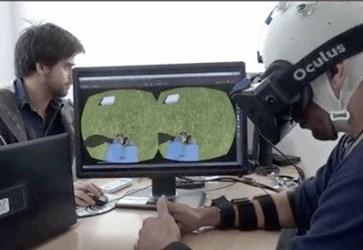Brain Training, Robotics Restore Partial Mobility To Paraplegics

Next-generation prosthetics and exoskeletons are using brain-machine interfaces (BMIs) to restore mobility by connecting machines to the same neural circuitry that controlled the limbs of paraplegics prior to injury or stroke. Now, scientists at Duke University have demonstrated research that shows a similar brain-machine interface — a combination of “brain training,” virtual reality, and robotics—can restore partial sensation and movement to limbs paralyzed for years, even decades.
Recently developed prosthetics are based on the idea that the brain and connected nerves are capable of communicating with machines even after they have been disconnected, either by limb loss or paralysis, from a patient’s arms and legs. Research with implants suggests that, even in diagnosed cases of complete paralysis, scientists may be able to bypass the point of injury and restore movement.
Miguel Nicolelis, Duke University neuroengineer and founder of the Walk Again Project, has been working for decades using brain-machine interfaces to develop exoskeletons and machinery that could provide paralyzed patients with an alternative form of movement. The project — which brings together over 100 scientists from 25 countries — kicked off at the World Cup in Rio de Janeiro in 2014, when Juliano Pinto kicked a soccer ball using robotic exoskeleton, reported the BBC.
Working with eight patients paralyzed for at least five years, Nicolelis and his team designed a system where participants wore fitted caps that recorded EEG brain function and sleeves that provided haptic feedback and attempted to control a virtual avatar using their minds. The long-term goal of the research was to train the patients to use robotic exoskeletons, but unexpectedly the team began to observe “significant clinical improvement” in both sensation and movement, demonstrated in a study published by Scientific Reports.
“What we’re showing in this paper is that patients who used a brain-machine interface for a long period of time experienced improvements in motor behavior, tactile sensations, and visceral functions below the level of the spinal cord injury,” said Nicolelis to Duke Today. “Until now, nobody has seen recovery of these functions in a patient so many years after being diagnosed with complete paralysis.”
Though success of the “brain training” varied, doctors upgraded diagnoses from complete paralysis to partial for all but a few of the study’s participants. Many patients demonstrated better bowel and bladder control, and some managed enough limb movement to power robotic exoskeletons.
According to Nicolelis, previous scientific studies have shown that remaining spinal nerves might go dormant following an injury, and patients diagnosed with complete paraplegia may just require some exercise and stimulation to wake them up.
In a study published last year in the Journal of Neurotrauma, scientists from UCLA demonstrated that non-invasive spinal cord stimulation may successfully rekindle spinal cord nerve activity when used in conjunction with drugs and conditioning.
“This is a wake-up call for how we see motor complete spinal cord injury,” said Reggie Edgerton, leader of the study, adding that partially remaining nerve function may be more common than we currently believe.
Though the findings from Duke University seem promising, experts told NPR that the findings were not conclusive, citing the lack of a control group in the study or definitive evidence of which technology improved function.
